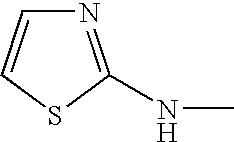Renin inhibitors
a renin inhibitor and renin technology, applied in the field of renin inhibitors, can solve the problems of insufficient soluble renin inhibitors that can be prepared on a large scale, high cost of goods, and the stop of the clinical development of several compounds, etc., and achieves low molecular weight, high in vitro activity, and high cost of goods.
- Summary
- Abstract
- Description
- Claims
- Application Information
AI Technical Summary
Benefits of technology
Problems solved by technology
Method used
Image
Examples
preparation b
tert-butyl (S)-2-amino-3-((R)-tetrahydro-2H-pyran-3-yl)propyl(methyl)carbamate
[0443]
Step 1. (S)-2-amino-3-((R)-tetrahydro-2H-pyran-3-yl)propan-1-ol
[0444](S)-tert-butyl 2,2-dimethyl-4-(((R)-tetrahydro-2H-pyran-3-yl)methyl)oxazolidine-3-carboxylate was prepared using procedures described in U.S. Provisional App. No. 60 / 736,564 filed on Nov. 14, 2005 and PCT App No. PCT / US2006 / 043920 filed Nov. 13, 2006, the entire contents of which are hereby incorporated by reference.
[0445](S)-tert-butyl 2,2-dimethyl-4-(((R)-tetrahydro-2H-pyran-3-yl)methyl)oxazolidine-3-carboxylate (32 g) was dissolved in a mixture of TFA (160 mL) and water (160 mL). The mixture was stirred at room temperature for 10 mins. The mixture was then concentrated in vacuo to give the crude product (50 g), which was used for the next step without further purification.
Step 2. benzyl (S)-1-hydroxy-3-((R)-tetrahydro-2H-pyran-3-yl)propan-2-ylcarbamate
[0446]To a solution of (S)-2-amino-3-((R)-tetrahydro-2H-pyran-3-yl)propan-1-ol ...
example 1
methyl 3-((5-chloro-2-methylphenyl)((R)-1-((S)-1-cyclohexyl-3-(methylamino)propan-2-ylcarbamoyl)piperidin-3-yl)amino)propylcarbamate
[0451]
Step 1. tert-butyl (S)-2-(3-((3-(methoxycarbonylamino)propyl)(5-chloro-2-methylphenyl)amino)piperidine-1-carboxamido)-3-cyclohexylpropyl(methyl)carbamate
[0452](S)-tert-butyl 2-amino-3-cyclohexylpropyl(methyl)carbamate (48 mg, 0.177 mmol), prepared using procedures described in U.S. Provisional App. No. 60 / 616,770 filed on Oct. 7, 2004 and PCT App No. PCT / US2005 / 036230 filed Oct. 7, 2005 the entire contents of which are hereby incorporated by reference, and CDI (29 mg, 0.177 mmol) dissolved in dry CH2Cl2 (2 mL) under ice-water bath, DIEA (151 mg, 1.17 mmol) was added. The reaction mixture was stirred for 1 h at room temperature and added a solution of methyl 3-((5-chloro-2-methylphenyl)(piperidin-3-yl)amino)propylcarbamate (60 mg, 0.177 mmol) in dry CH2Cl2 (1 mL). The reaction mixture was stirred at room temperature overnight and then washed with w...
example 2
(S)-Methyl 3-((3-chlorophenyl)(3-(1-cyclohexyl-3-(methylamino)propan-2-ylcarbamoyl)phenyl)amino)propylcarbamate
[0457]
Step 1. (S)-2-(trimethylsilyl)ethyl 2-(3-bromobenzamido)-3-cyclohexylpropyl(methyl)carbamate
[0458]A mixture of 3-bromobenzoic acid (629.0 mg, 3.13 mmol, 1.0 equiv), (S)-2-(trimethylsilyl)ethyl 2-amino-3-cyclohexylpropyl(methyl)carbamate (1.10 g, 3.49 mmol, 1.11 equiv), EDC (1.29 g, 2.15 equiv), and DIEA (4 mL) in CH2Cl2 (20 mL) was stirred at room temperature for 2 d. After evaporation of solvent, the residue was purified by chromatography on silica gel eluted with hexanes / ethyl acetate to afford (S)-2-(trimethylsilyl)ethyl 2-(3-bromobenzamido)-3-cyclohexylpropyl(methyl)carbamate. ESI MS: 497 (M+H+).
Step 2. tert-butyl 3-(3-chlorophenylamino)propylcarbamate
[0459]A mixture of 1-chloro-3-iodobenzene (1.51 g, 6.32 mmol, 1.0 equiv), tert-butyl 3-aminopropylcarbamate (1.20 g, 6.89 mmol, 1.09 equiv), K2CO3 (2.16 g, 15.64 mmol, 2.47 equiv), CuI (0.14 g, 0.72 mmol, 0.11 equiv)...
PUM
| Property | Measurement | Unit |
|---|---|---|
| diameter | aaaaa | aaaaa |
| diameter | aaaaa | aaaaa |
| diameter | aaaaa | aaaaa |
Abstract
Description
Claims
Application Information
 Login to View More
Login to View More - R&D
- Intellectual Property
- Life Sciences
- Materials
- Tech Scout
- Unparalleled Data Quality
- Higher Quality Content
- 60% Fewer Hallucinations
Browse by: Latest US Patents, China's latest patents, Technical Efficacy Thesaurus, Application Domain, Technology Topic, Popular Technical Reports.
© 2025 PatSnap. All rights reserved.Legal|Privacy policy|Modern Slavery Act Transparency Statement|Sitemap|About US| Contact US: help@patsnap.com



